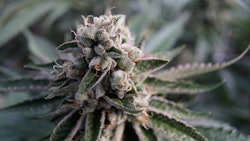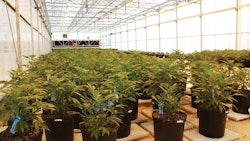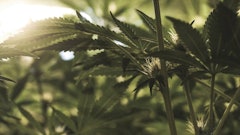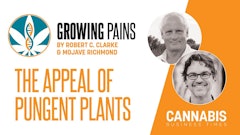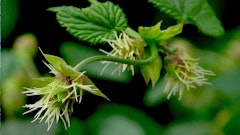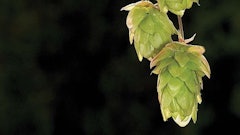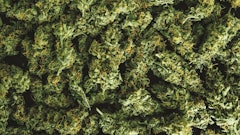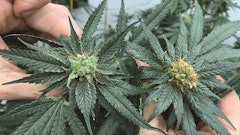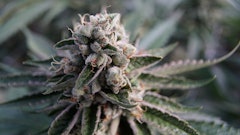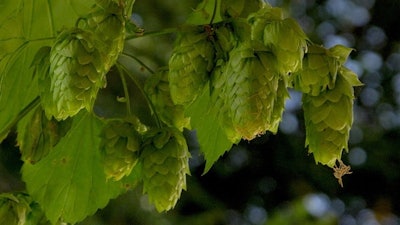
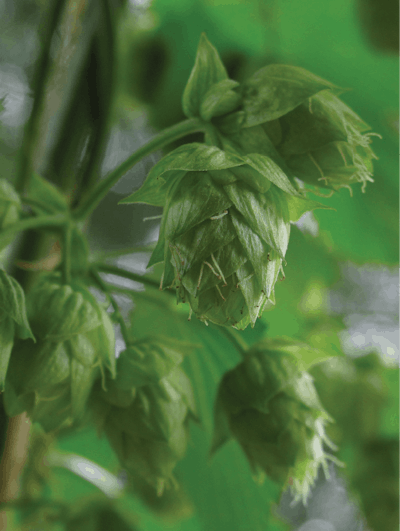
Hop-forward beers with complex aromas are sweeping the market. Pioneered by innovative North American craft brewers, many of the major breweries have been quick to add India Pale Ales (IPAs)—beers traditionally recognized for their hoppy bitterness—to their expanding product lines. Modern-day IPAs and other craft beers are increasingly hopped with aromatic cultivars that impart their characteristic bitterness to beer and also express fruity, floral and herbal terpene aromas and flavors resembling those of cannabis flowers. The relationship between buds and suds are often enjoyed in social settings, and the enhanced effects of consuming hoppy beers are often discussed on beer blogs. Is exploring the heightened effects of consuming hoppy beer and terpy cannabis together the natural next step?
Smoking and drinking in moderation go hand-in-hand, as any bar owner will attest. Many people relax after work with a smoke and a beer. So, what could be so special about using cannabis and drinking terpy beer compared to regular beer? Isn’t it just about the THC and ethanol?
Hop and Hemp
Humulus and Cannabis are each other’s closest botanical relatives. Female Humulus lupulus, or common hop plants, are commercially grown to produce the flowers called “hops,” which are most often dried and used in brewing beer. Hops are grown seedless to encourage the production of bitter alpha-acids and the aromatic terpenes important in brewing, much as cannabis flowers are grown seedless to encourage the production of cannabinoids and terpenes. Seeds only add to the weight, which increases the cost of the hops, while diminishing the target compound contents. And oily seeds are no more desirable in beer than they are in sinsemilla flowers.
OK, so Cannabis and hops are related. Why would consuming one enhance the effects of the other? The simple answer is that they both contain similar suites of aromatic terpenes. Only Cannabis plants produce cannabinoids (e.g., THC and CBD), while both Cannabis and hops produce a wide range of the same aromatic terpene compounds. The characteristic compounds found in hops that account for the bitter taste of beer are alpha-acids, especially humulone, which is absent from Cannabis. Humulone should not be confused with the terpene humulene, which is commonly found in both Humulus and Cannabis flowers. These closely related plant groups evolved from a common ancestor, and it is instructive to compare the aromatic contents of Cannabis essential oil to that of its near relative, and to understand which terpenes and other aromatic compounds are also shared by Humulus. (See the “A Closer Look: Terpenes in Cannabis and Hops” box below.)
Myrcene is the predominate terpene found in both Cannabis and Humulus and can make up more than three-quarters of the terpene content in some samples. Caryophyllene and the farnesenes are also found in high concentrations in both hemp and hops. Pinene is prevalent in Cannabis, while humulene is prevalent in Humulus and is one of the terpenes preferred by brewers. Limonene is a major Cannabis terpene, occasionally exceeding myrcene levels, and along with terpinolene, ocimene, carene and the phellandrenes, can have a major presence in Cannabis but usually only a minor presence in Humulus. On the other hand, bisabolenes, selinene, bergamotene, aromadendrene and spathulenol are more common in Humulus and only appear in smaller amounts in Cannabis. Brewer’s hops are usually myrcene and humulene dominant with the remaining terpenes found in much smaller amounts, and Humulus does not produce such a complex array of terpenes as Cannabis.
Without hops, beer is mostly fermented barley mash, water and ethyl alcohol. Ethanol is essentially a one-dimensional drug with limited variation of effect. The aromatic constituents of hops add a vivid spectrum to the basic shades-of-gray palette provided by alcohol alone. Sinsemilla contains predominately THC, a single psychoactive compound, as well, but supported by a wide range of aromatic terpene compounds that modify the effects of THC alone. Although Cannabis and Humulus plants share several common terpenes, others occur in both more rarely, and some are produced by only one genus or the other. Possibly cannabis adds to hoppy beer a broader spectrum of terpenes and thereby enhances a more well-rounded and complete experience. Terpenes may also create an olfactory bridge between the effects of consuming cannabis and the effects of drinking beer. The aromas common to both sinsemilla and hop flowers enhance the blending of these pleasurable experiences. In addition, subtle psychoactive effects induced by individual terpenes and aromatic blends may enhance the combined experience.
Historical Hops
Hops have long been associated with adding special properties to beers. “The Hop Farmer: A Complete Account of Hop Culture,” written in 1838 by agricultural writer E. J. Lance, informs us of the psychoactive potential of hoppy ales: “It is the opinion of brewers that the intoxicating qualities of ale are to be partly ascribed to the oil of the hop. … As a narcotic its powers are known in beer, and have been often used to produce sleep from the smell only … .”
Among beer lovers, the effects of hops are increasingly discussed. A brief survey of beer blogs discovered several effects attributed to hop-forward craft beers—especially those brewed with the particularly aromatic American hop varieties—including more vivid dreams, euphoric happiness and sedation.
Lance also writes that Georgian- and early-Victorian-era hops were smoked for their flavorful terpene content as well as their medicinal effects: “In a productive year any means of using up the hops will be of service to the growers, it is therefore recommended to be smoked instead of tobacco, or it may be mixed therewith; it is grateful to the taste and smell, and moreover will cure rheumatic pains by using in this way.”
These observations add credibility to the hypothesis that drinking hoppy beers can produce subtle effects above and beyond those from alcohol, and that an abundance of aromatic hops can enhance the experience of drinking beer.
Craft brewers have become increasingly transparent in their presentation of the hop and cannabis relationship. Some make subtle wink-wink, nudge-nudge allusions while more bold brewers leave no doubt where they stand. Hop Valley Brewing Company’s Bubble Stash IPA label encapsulates the cannabis persuasions of their intended customer base: “Our brewers reached into their secret stash of mosaic cryo hop resin to create a tropical dankness in this new age IPA. Take a hit of these bright sweet fruit notes in the easy drinkin’ bubbler. You won’t want to pass this one!”
Aromatic sinsemilla flowers and hoppy beers are a marketing match made in heaven. There are so many ways to present the relationships between both plants to the modern marketplace. We will surely see many innovative business models succeed. Our future is on our doorstep!
What’s All the Fuss About?
Regulated cannabis environments generally prohibit publicly smoking otherwise legal cannabis. Consumers can buy cannabis from a licensed retailer but must take their purchase off-premises to even open the package. Most hotels, bars and restaurants do not allow smoking, or any cannabis consumption for that matter. Smoking while driving is illegal, and street consumption is certainly uncool and can result in fines. So what are honest cannabis consumers to do?
Demand for mixed consumption venues is high. In several jurisdictions, strict adult-use laws segregating consumption of food and drink from smoking of any kind are yielding to mixed consumption venues where cannabis can be purchased on site and smoked in designated areas. We believe food, alcohol and cannabis consumption will begin to occupy the same commercial spaces. Given the reservations of policy makers toward smoking, it likely will be quite some time before permits are issued for mixed consumption venues—but we already see mixed consumption at conferences and concerts where food and alcohol are served and smoking is tolerated within defined areas. Co-consumption is what consumers want, and they usually get their way. As we always say, just follow the money! As profitable co-consumption business models begin to unfold, they will rapidly gain in popularity. It will soon become increasingly important to more extensively explore and understand the synergistic relationships between Cannabis and Humulus plants and their products.
We are just now learning how the numerous aromatic compounds synthesized by Cannabis plants help shape the effects associated with various cultivars. It would be naive to assume that the terpenes in cannabis products do not interact synergistically with foods and beverages, as well. Our as yet limited understanding of the “ensemble effect” among cannabinoids, terpenes and myriad other compounds contained in Cannabis plants is already opening the door to understanding the complex chemical interplay sculpting the effects achieved by using cannabis products. Although in comparison to cannabis consumption, terpenes may play a lesser role in shaping the inebriating effects of beer drinking, it would be equally naive to assume that they exert no effect at all.
Our preferences for various cannabis and hop aromas are rooted in our associations with other plants and our previous experiences. The sustained popularity of modern, highly aromatic “loud” cannabis and the proliferation of hoppy IPAs are strong testaments to the complex role plants and their various chemical constituents play in consumers’ lives. Understanding how certain aromatic compounds potentiate, modulate and regulate the actions and effects of other active ingredients and the influences of these effects on forming individual aroma preferences presents a mountain yet to climb.







